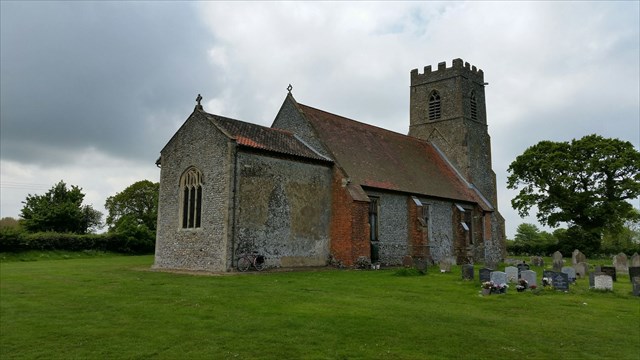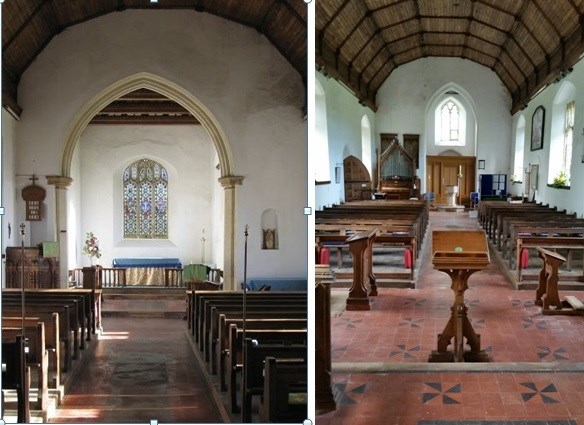
The interior is light and warm, although on the day I visited the door closed very firmly behind me when I left, and I felt as though ’ someone or something’ was seeing me out’!
Whilst I was there two people arrived to tend a grave and a further two turned up to maintain the churchyard showing that, despite its distance from the village, the church is much cared for and appreciated.
All Saints was mentioned in the Doomsday Book (dated 1086) and therefore a church here predates that entry.
There are evidences of Saxon remains in the fabric of the church. The greater part of the present fabric is medieval, i.e. Tower, Porch and Chancel. The Nave has been restored many times over the years, the last major restoration being mid-Victorian when much alteration took place.
The Nave at one time was at a higher level - the marks of the original are still to be seen on the tower.
In the South Porch are the remains of a holly water stoup; only the original glazed tiling is left. The oak door was installed in 1919 as part of a memorial, together with repairs to the church, to the fallen in the Great War 1914-18.

In 1859 comprehensive restoration took place on the tower. At that time the wood taken from the old box pews was used to make a floor for the bell chamber. These are clearly visible. In 1919 further work was carried out. This was done by subscription at a cost of £250. A memorial to the fallen in the Great War 1914-18 was placed on the South Wall of the church. There were originally traces of a decorated western doorway - subsequently this was replaced by the present door which was dedicated by the Bishop of Lynn in September 1978.
Originally there were three bells in the tower. In 1828 the parishioners had to sell two of the three bells, which raised £43.9s.0d. to help pay for repairs to the church amounting to £290. The bell which is hanging in the tower at present bears the inscription 'Thomas Mears - London 1840'.
The east window, which was installed in the 16th century, fell into decay, together with the whole church. In 1859 the present window was installed by public subscription as a memorial to the wife of the Rev. John Partridge, and represents the Nativity, Crucifixion and Ascension.

The communion plate consists of an ancient flagon, chalice and paten. The flagon has the arms of Stuart and is inscribed 'The gifte of Mary Ann Stuart 1774'. (This lodged in the bank for safe keeping.)
In a record of the church dated 1902 it was stated that - 'the seating for the congregation accommodates 260 persons on open benches'. The pews at present in church were originally in the chapel of the Beckham Workhouse, and when this was no longer used they were offered to All Saints, Bodham and were installed in 1959. They provide seating for a congregation of 72.
You are looking for a micro container which is a little smaller than a film canister. Please bring your own pen. The cache is roadside so take care with small children.
****************** ********************
For full information on how you can expand the Church Micro series by sadexploration please read the Place your own Church Micro page before you contact him at churchmicro@gmail.com.
See also the Church Micro Statistics and Home pages for further information about the series.
****************** *******************